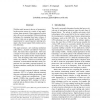Free Online Productivity Tools
i2Speak
i2Symbol
i2OCR
iTex2Img
iWeb2Print
iWeb2Shot
i2Type
iPdf2Split
iPdf2Merge
i2Bopomofo
i2Arabic
i2Style
i2Image
i2PDF
iLatex2Rtf
Sci2ools
132
click to vote
CIDR
2003
2003
Indexing Large Trajectory Data Sets With SETI
With the rapid increase in the use of inexpensive, location-aware sensors in a variety of new applications, large amounts of time-sequenced location data will soon be accumulated. Efficient indexing techniques for managing these large volumes of trajectory data sets are urgently needed. The key requirements for a good trajectory indexing technique is that it must support both searches and inserts efficiently. This paper proposes a new indexing mechanism called SETI, a Scalable and Efficient Trajectory Index, that meets these requirements. SETI uses a simple two-level index structure to decouple the indexing of the spatial and the temporal dimensions. This decoupling makes both searches and inserts very efficient. Based on an actual implementation, we demonstrate that SETI clearly outperforms two previously proposed trajectory indexing mechanisms, namely the 3D R-tree and the TB-tree. Unlike previously proposed trajectory indexing structures, SETI is a logical indexing structure th...
Related Content
| Added | 31 Oct 2010 |
| Updated | 31 Oct 2010 |
| Type | Conference |
| Year | 2003 |
| Where | CIDR |
| Authors | V. Prasad Chakka, Adam Everspaugh, Jignesh M. Patel |
Comments (0)

